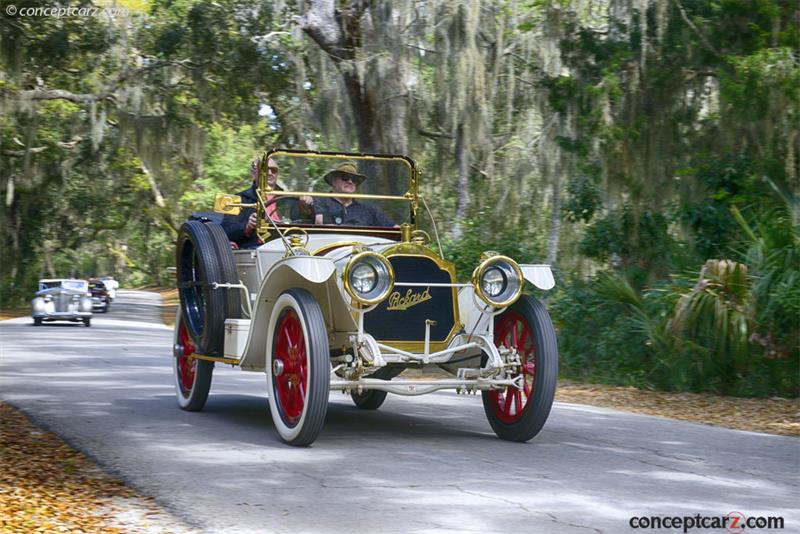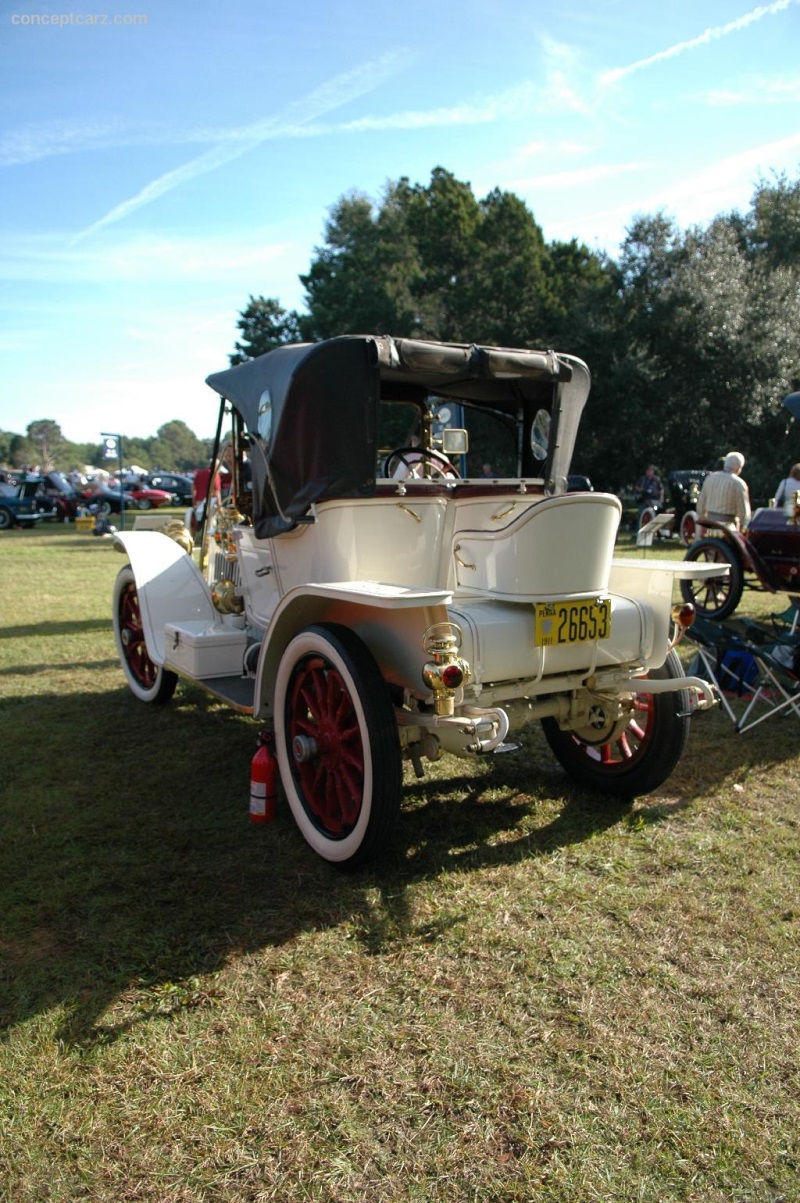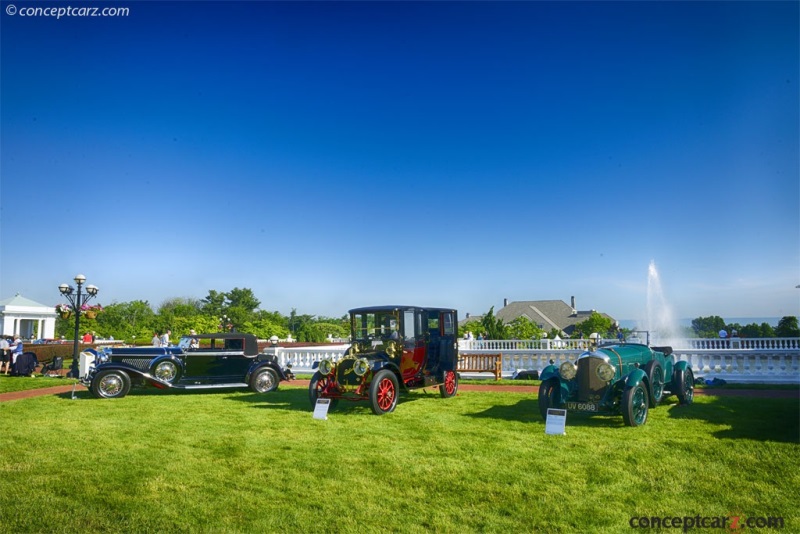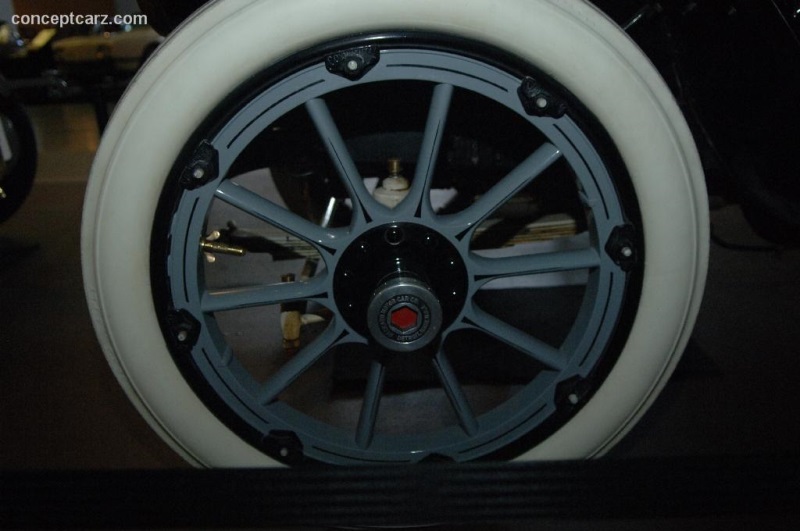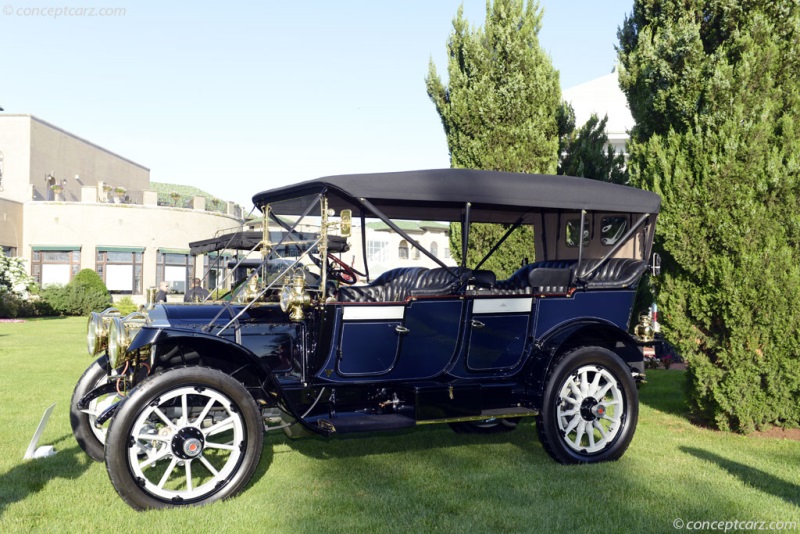The first four-cylinder model produced by the Packard Motor Car Company was the Model K of 1903 and with a price tag in excess of $7,000, it was one of the most expensive cars on the market. The four-cylinder unit had a 4-inch bore and 5-inch stroke developing 24 horsepower at 1,000 RPM. It used a four-speed sliding gear transmission, mechanical brakes on the rear wheels, and rested on a 92-inch wheelbase platform. In comparison, the one-cylinder Model F used an 88-inch wheelbase, and its horizontally opposed 183.8 cubic-inch engine developed 12 horsepower at 850 RPM and was listed for $2,250. The Model F used the same engine as the previous Model C from 1901, but its body design was very different, signaling the shift from 'buggy' to modern 'automobile.' The four-cylinder Model K was the first Packard with its engine located in the front and the first to use a four-speed transmission. Due to its very steep price, production was modest, with just 34 examples built, the most famous being the 'Gray Wolf' that was raced by Packard engineer Charles Schmidt.
Touring
View info and historyFour-cylinder engines were the sole source of power for Packard until the arrival of the Model 1-48 'Six' in 1912. The Model L of 1904 was priced at $3,000 and its 241.7 cubic-inch L-head four produced 22 horsepower at 900 RPM. Its 94-inch wheelbase grew to 106 inches a year later with the Model N and provided a suitable platform for several new body styles. The four-cylinder engine gained six more horsepower than the previous Model L, thanks in part to an auxiliary automatic inlet and warm water jacket, along with a single-jet carburetor. By 1906, the Model S was priced from $4,000 to $5,200 depending on coachwork, and its wheelbase now measured 119 inches. The runabout, priced at $4,000, rested on an exclusive 108-inch wheelbase. The engine powering the Model S was a T-head design with a cast-iron block, three main bearings, solid valve lifters, a 349.9 cubic-inch displacement, and developed 24 horsepower at 650 RPM. It was backed by a three-speed sliding gear transmission on the rear axle, and mechanical brakes on the two rear wheels. The Model S was popular, with 728 examples sold compared to 403 of the 1905 Model N and 207 of the Model L.Packard Model Thirty
The Model Thirty was Packard's final four-cylinder model (along with the downsized Model 18 introduced in 1909 and produced through 1912). The Model Thirty was introduced in 1907 and would remain in production through 1912. It was similar to the Model S, but with several significant improvements. The wheelbase for the runabout continued to measure 108 inches, but the rest of the body styles rested on a larger 122-inch platform (compared to 119 inches of the Model S). The previous dome top of the cylinder tops and valve chambers were now flat, and the valves were larger. Its bore measured 5 inches and its stroke 5.5 inches (compared to the 4.5-inch bore and 5.5-inch stroke of the Model S) giving it a displacement size of 431.9 cubic inches. It produced 30 horsepower at 650 RPM which inspired the 'Model Thirty' name. The list of standard equipment included headlights, a tire repair kit with a jack and pump, irons for carrying extra tires, and irons for an extension cape cart top. The three-speed sliding gear transmission used an expanding flywheel clutch and shaft drive with a bevel gear differential. Mechanical brakes operated on the rear wheels, and the front wheels now ran on ball (replacing the previous roller) bearings. Prices ranged from $4,200 to $5,600 and a total of 1,128 examples were sold in its inaugural year of production.
Touring
View info and historyThe Model Thirty was the only model offered by Packard in 1907 and 1908. For 1908, a new close-coupled touring car with a one-person rumble seat joined the runabout, tourer, limousine, and Landaulet. The wheelbase now measured 123.5 inches but the runabout continued to rest on the 108-inch platform. The Model Thirty received larger wooden artillery wheels and a lowered frame, with prices remaining consistent with the previous year. Sales improved slightly to 1,303 units.The Model Thirty was joined by a more affordable model called the Model Eighteen in 1909, with prices that ranged from $2,900 to $4,300. It used a 112-inch wheelbase and a 265.7 cubic-inch T-head four-cylinder engine with three main bearings, solid valve lifters, and produced 18 horsepower at 650 RPM. The list of body styles initially included a landaulet, touring, limousine, and runabout (on a 102-inch wheelbase) with a demi-limousine added near the close of 1909. During its inaugural year, 802 examples were sold compared to 1,501 of its larger sibling. Packard had hoped the lower-priced model would generate more sales but this was not the case, and sales would continue to decline, with 766 examples sold in 1910, 360 in 1911, and 350 in 1912. Minor modifications were bestowed upon the 1909 Model Thirty including a four-gallon gasoline reserve tank, a redesigned linkage, and hooded front fenders with a mudguard. 
Touring
View info and historyBoth the 1910 Model Thirty and Eighteen were given the same refinements, with prices of the Model Thirty and Model Eighteen remaining the same as in previous years (the price of the Model Eighteen Limousine did rise by $100 to $4400). The expanding ring clutch was replaced by a dry plate unit, mechanical brakes continued to stop the rear wheels, and wood artillery wheels still graced all four corners of the vehicles. The suspension gained shock absorbers for added comfort, and the steering wheel and front fenders grew larger. A Phaeton body style joined the Model Thirty. The Model Eighteen gained a new close-coupled touring and coupe in 1911, with prices that ranged from $3,200 for the tourer and runabout to $4,400 for the limousine. Sales continued to be disappointing with just 360 units sold, compared to 1,865 of the Model Thirty, and though the styling and mechanical changes made to the Model Thirty were applied to the Model Eighteen. The 1911 Packards received all-new standard paint schemes in Packard blue with gray striping. The frame, hood, radiator, fenders, moldings, battery, and toolboxes were painted black. Cars with open body styles had their axles, wheels, and running gear (below the frame), painted gray with black striping while open cars had the opposite scheme - black with gray striping. Closed body styles had untufted straight-grain leather in the front with tufted blue goatskin in the rear combined with untufted blue broadcloth for the roof and quarters. The open-body styles were finished in tufted straight-grain leather. 
Touring
View info and historyThe mechanical changes were minimal with the biggest improvement being the addition of three short leaves to the rear semi-elliptic suspension. A Brougham and Coupe body style joined the lineup, which now was priced from $4,200 for the touring and runabout to $5,500 for the Phaeton. The wheelbase was slightly shorter at 123 inches (a loss of about a half-an-inch from the previous year) and the runabout continued to rest on the shorter 108-inch platform. New options joined the list including electric side and rear lights with a separate body to power them. 1912 was the final year for the Packard Model Eighteen and Model Thirty. They were joined by a new six-cylinder model dubbed the Series 1-48 Six whose 525 cubic-inch T-head six developed 74 horsepower at 1,720 RPM. The Phaeton and Brougham body style rested on a 139-inch wheelbase, the Coupe and Runabout on a 121.5-inch platform, and the remaining body styles on a 133-inch wheelbase. Thirteen catalog body styles were offered with prices that ranged from $5,000 to $6,350. The 1912 Packard Model Eighteen continued to rest on a 112-inch wheelbase for most of its body styles with the runabout on the shorter 108-inch platform (six inches longer than the previous year). Both the Model Eighteen and Model Thirty received a re-engineered clutch design with the dry disc clutch now positioned directly behind the engine, and the clutch and flywheel were now an extension of the crankcase. The popularity of the Model Eighteen continued to be low, with just 350 built in its final year. 
Touring
View info and historyThe 1912 Packard Model Thirty saw a decline of popularity to 1,250 sales, perhaps due to the Series 1-48 alternative. In its final year of production, Packard mounted the Runabout on a 114-inch wheelbase, the Limousine and Laundaulet on a 129.5-inch wheelbase, and the rest of the body styles on a generous 123.5-inch wheelbase. The brougham was a new body style and listed for $5,500. The Phaeton, Tourer, and runabout were priced at $4,200, the coupe at $4,900, and the limousine at $5,450 - the landaulet was $100 higher. The 431.9 cubic-inch engine continued to develop 30 horsepower at 650 RPM and was backed by a sliding gear transmission. The list of standard equipment now included the previously optional combination oil and electric side and rear lights. Gas was used for the headlights. The Packard marque had built its foundation on durability and the Packard Model Thirty had continued this pursuit. Prior to the introduction of the Model 30 in August 1906, the car had undergone over 50,000 test miles. The test car was nicknamed Gasoline Gus and in one test, Gus covered 606 miles on Michigan's sandy roads in a single day without adjustments or repairs. The only exception was having to replace one tire. This test run was a world record and Packard would capitalize on it with a special brochure titled The Flight of the Thirty. 
Touring
View info and historyA total of 9,540 examples of the Model Thirty were built from 1907 through 1912 with its best year being 1910 when 2,493 were sold. On a final thought, Cadillac also produced a model called the Model 30 from 1908 through September 1914. It had a 106-inch wheelbase and was equipped with a 226.2 cubic-inch engine backed by a three-speed selective sliding gear transmission with mechanical brakes on the rear wheels. Prices began at $1,400 in 1908 and rose to $1,600 by 1910, and nearly $2,000 by 1912.
by Daniel Vaughan | Oct 2021
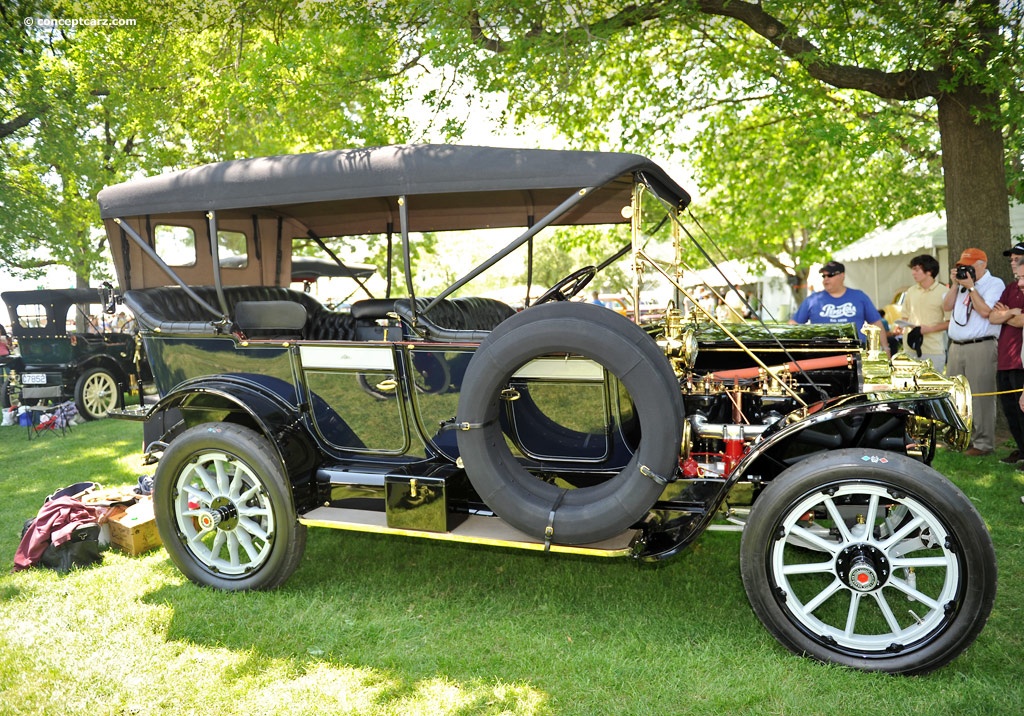
Touring
View info and history
The Model Thirty was Packard's final four-cylinder model (along with the downsized Model 18 introduced in 1909 and produced through 1912). The Model Thirty was introduced in 1907 and would remain in production through 1912. It was similar to the Model S, but with several significant improvements. The wheelbase for the runabout continued to measure 108 inches, but the rest of the body styles rested on a larger 122-inch platform (compared to 119 inches of the Model S). The previous dome top of the cylinder tops and valve chambers were now flat, and the valves were larger. Its bore measured 5 inches and its stroke 5.5 inches (compared to the 4.5-inch bore and 5.5-inch stroke of the Model S) giving it a displacement size of 431.9 cubic inches. It produced 30 horsepower at 650 RPM which inspired the 'Model Thirty' name. The list of standard equipment included headlights, a tire repair kit with a jack and pump, irons for carrying extra tires, and irons for an extension cape cart top. The three-speed sliding gear transmission used an expanding flywheel clutch and shaft drive with a bevel gear differential. Mechanical brakes operated on the rear wheels, and the front wheels now ran on ball (replacing the previous roller) bearings. Prices ranged from $4,200 to $5,600 and a total of 1,128 examples were sold in its inaugural year of production.
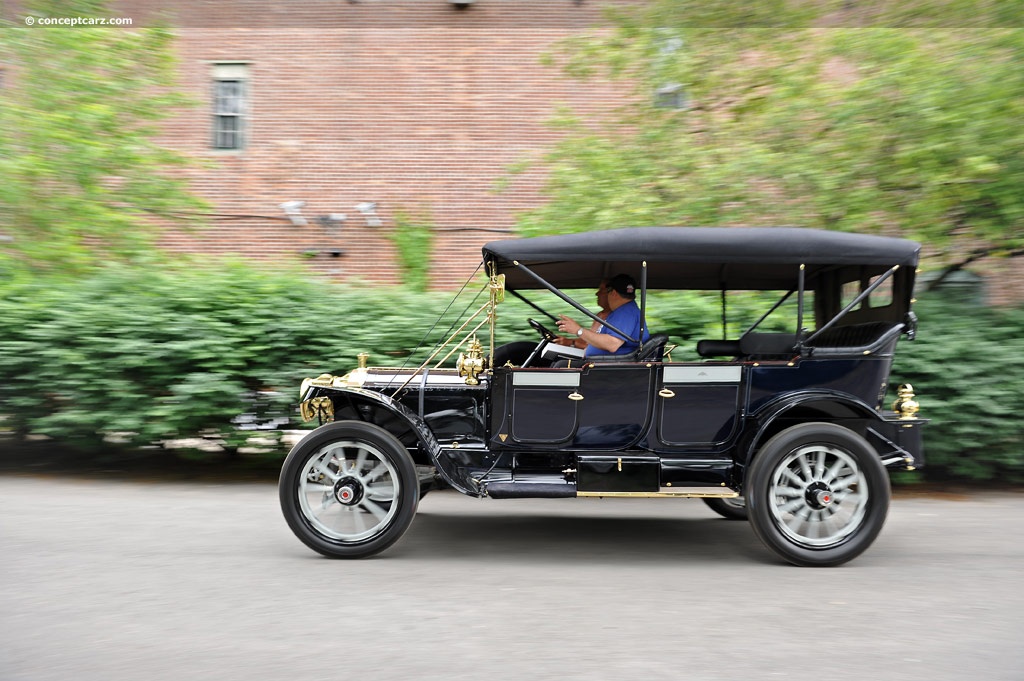
Touring
View info and history
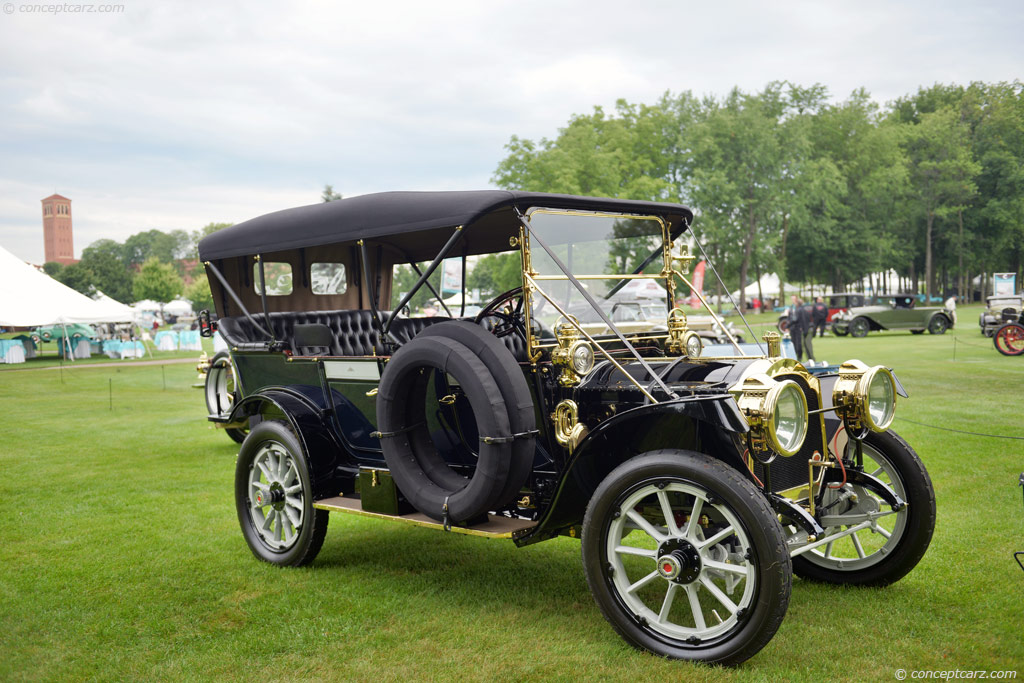
Touring
View info and history
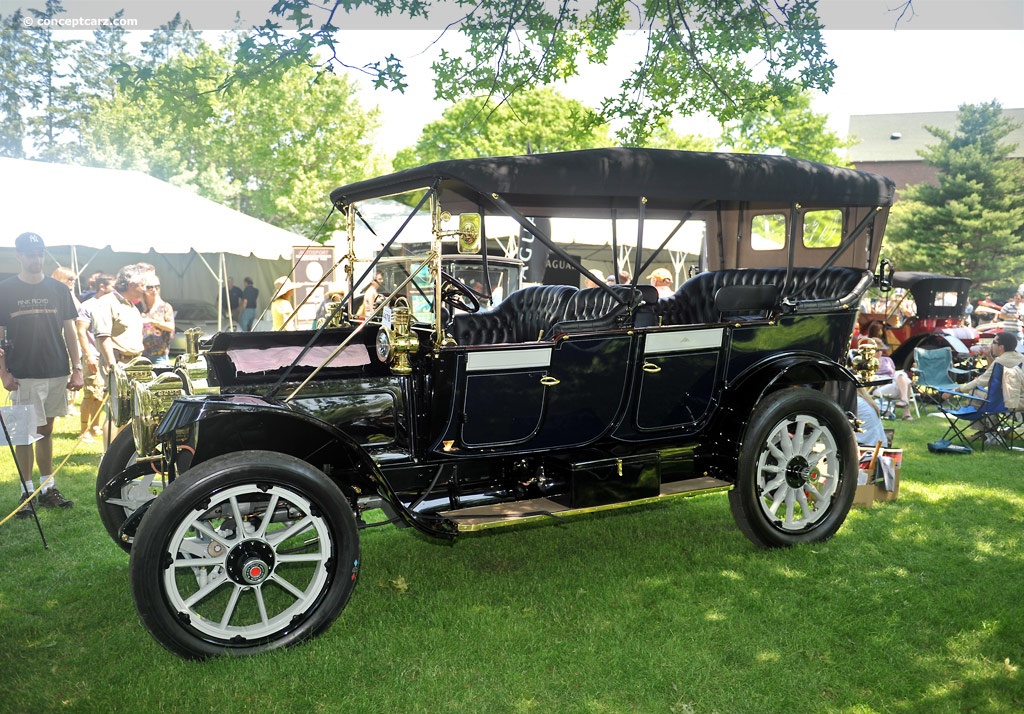
Touring
View info and history
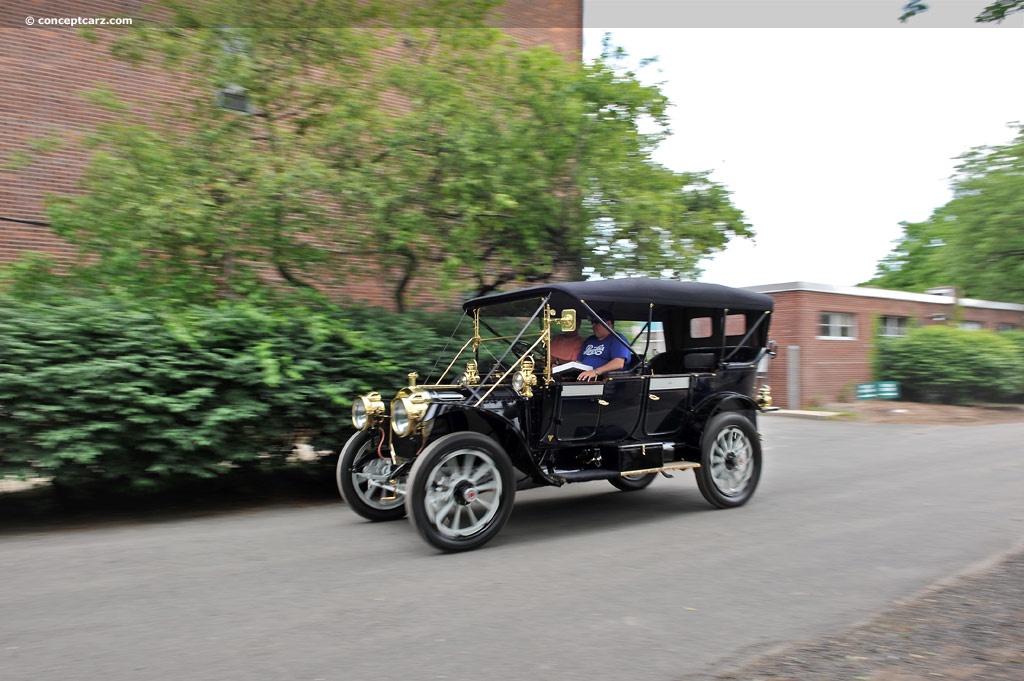
Touring
View info and history
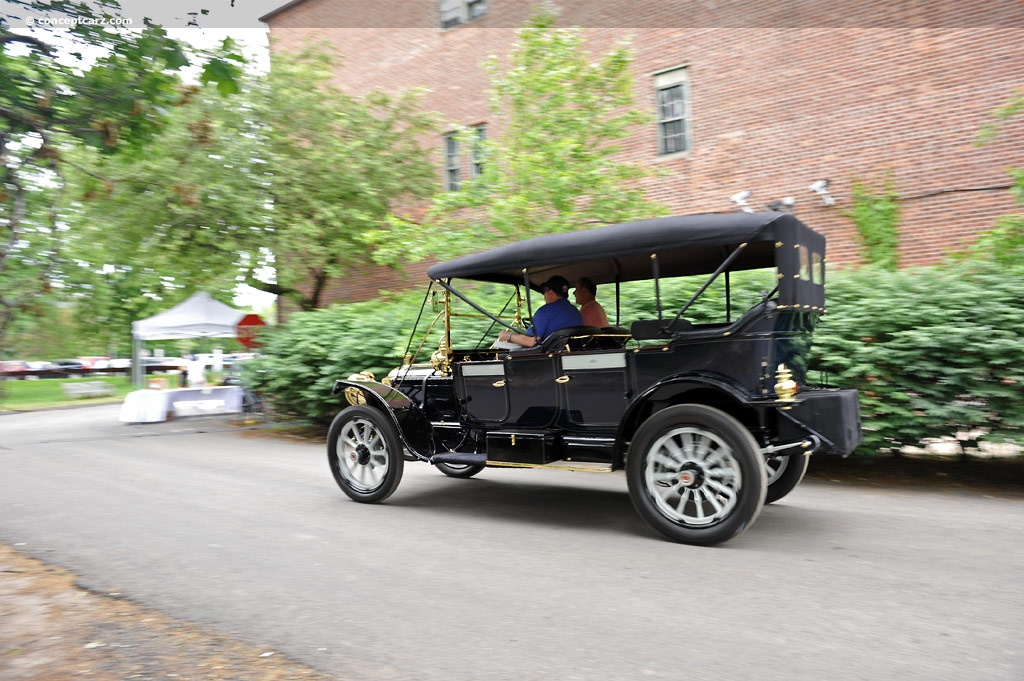
Touring
View info and history
by Daniel Vaughan | Oct 2021
Related Reading : Packard Model 30 History
The slogan Ask The Man Who Owns One is one of the most famous in American History. It was the response given to most individuals when asked about a Packard. They were reliable, elegant, powerful, and quality automobiles. Their attention to detail and ingenuity were some of the key factors in making the company successful. The Packard legend began in 1898 when James Ward Packard, a mechanical....
Continue Reading >>
Continue Reading >>
Related Reading : Packard Model 30 History
The Packard Motor Company displayed its first motor carriage in 1900, at the first New York City auto show. Three years later, the Packards had improved significantly and their reliability was greatly increased. A 1902 Model F fitted with a Packard single-cylinder 12 horsepower engine and automatic ignition advance made the transcontinental trip from San Francisco to New York in 53 days. In 1907,....
Continue Reading >>
Continue Reading >>
Similar Automakers
Similarly Priced Vehicles
Pierce-Arrow Model 36 ($4,013-$5,044)
Simplex Model 50 ($4,500-$4,500)
Oldsmobile Limited ($4,995-$6,995)
Pierce-Arrow Model 48 ($5,030-$6,234)
Franklin Model D ($3,500-$4,400)
Oldsmobile Autocrat ($3,500-$5,000)
Lozier Model 51 ($5,500-$5,500)
American Model 50 Underslung ($5,000-$5,000)
Pope-Hartford Model Y ($4,000-$5,150)
Knox Model R ($250-$4,400)
Locomobile Model 30 ($3,500-$4,600)
Packard Model Eighteen ($3,200-$4,500)
Average Auction Sale: $146,650
Simplex Model 50 ($4,500-$4,500)
Oldsmobile Limited ($4,995-$6,995)
Pierce-Arrow Model 48 ($5,030-$6,234)
Franklin Model D ($3,500-$4,400)
Oldsmobile Autocrat ($3,500-$5,000)
Lozier Model 51 ($5,500-$5,500)
American Model 50 Underslung ($5,000-$5,000)
Pope-Hartford Model Y ($4,000-$5,150)
Knox Model R ($250-$4,400)
Locomobile Model 30 ($3,500-$4,600)
Packard Model Eighteen ($3,200-$4,500)
Average Auction Sale: $146,650
1911 Packard Model Thirty Vehicle Profiles
Recent Vehicle Additions
Performance and Specification Comparison
Price Comparison
$3,200 - $4,500
Model 30 Specification Comparison by Year
Year
Production
Wheelbase
Engine
Prices
Related Automotive News

A (Silver) Ghost Story For Christmas
Whether youre a long-time classic car owner looking to add to your collection, are about to take your first steps into the joy of classic car ownership or are planning to delight someone by presenting them with their own piece of four-wheeled history...

Top Three Finalists In SEMA's 'Battle Of The Builders' Roll On Coker Tires
Las Vegas (November, 2017) – All three finalists in the fourth annual SEMA Battle of the Builders competition were equipped with period-correct tires made or distributed by Coker Tire, as the highly anticipated event reached its culmination...

COKER DOMINATES THE FIELD AT PEBBLE BEACH CONCOURS
Coker Tire-equipped classics took home Best of Show and 15 Best in Class wins out of 26 classes, with 77 out of the 110 cars in pre-war classes riding on Coker Tires, at the prestigious Pebble Beach Concours dElegance.
Chattanooga, Tenn....
2015 Fall Carlisle Auction Preview
Carlisle Auctions Returns for its Annual Fall Carlisle Offering 2015 Two-Day Event Features Classics of all Eras
CARLISLE, PA – Success! What Carlisle Auctions has done since its inception in the fall of 2012 can be summed up with that...

Rolex Monterey Motorsports Reunion : A Brilliant Finish
There are times to spectate and there are times to roll up ones sleeves and participate. At the Rolex Monterey Motorsports Reunion this year, both options brought abundant joy, as more than 550 authentic and historic race cars from nearly every decade...





























